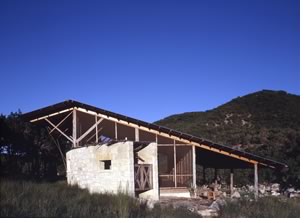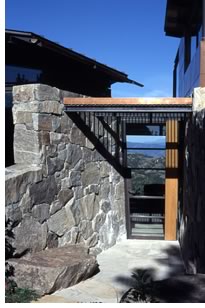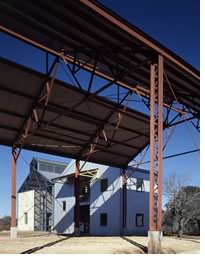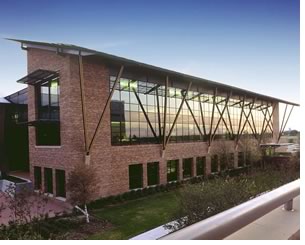

Lake/Flato Will Receive 2004 Firm Award
 The
AIA Board of Directors named Lake/Flato as recipient of the 2004 Architecture
Firm Award on December 4 at the Board of Directors meeting in Washington,
D.C.
The
AIA Board of Directors named Lake/Flato as recipient of the 2004 Architecture
Firm Award on December 4 at the Board of Directors meeting in Washington,
D.C.
“This takes my breath away, this is such an amazing honor!” exclaimed David Lake, FAIA, principal of the San Antonio-based firm, when notified by 2003 AIA President Thompson E. Penney, FAIA, that his practice had won the award. Compiling the submission, Lake said, “really makes you think a great deal about what it means to have an architecture firm that is more about the people of the firm and the body of work than about the individual.”
 The
Firm Award, the highest honor the AIA confers on an architecture firm,
recognizes a practice that has produced distinguished architecture consistently
for at least 10 years. Lake/Flato will be honored at the Accent on Architecture
gala March 3, 2004, in Washington, D.C.
The
Firm Award, the highest honor the AIA confers on an architecture firm,
recognizes a practice that has produced distinguished architecture consistently
for at least 10 years. Lake/Flato will be honored at the Accent on Architecture
gala March 3, 2004, in Washington, D.C.
Body of work
Lake/Flato’s roots are firmly affixed in San Antonio, yet they have
used their enriching approach to architecture across a vast array of places,
project types, and scales. With projects across the U.S. and in Mexico,
their work ranges from family retreats to museums and interpretive centers,
independent schools to universities, arboretums to corporate headquarters.
Over the last 20 years, the firm has won more than 90 regional and national
architecture awards, punctuated by AIA Honor Awards in 1992, 1997, and
1999.
Established in 1984, the 44-member firm notes that it derives its success from a talented, dedicated staff and an open culture that honors individual creativity and nurtures teamwork. The office contributes regularly to the profession through its AIA leadership and participation in lectures, symposia, juries, studio chairs, and mentorship of students and interns from across the country. They also lead various civic and environmental organizations across Texas to extend their influence beyond the boundaries of the profession. Their work within their own city has been instrumental in revitalizing the downtown area.
 The
firm’s projects include the new SBC center for the San Antonio Spurs
basketball team, the Louisiana State University/Hilltop Arboretum, Baton
Rouge; The Carver Academy, San Antonio; Great Northwest Branch Library,
San Antonio; and the Burlington Northern Santa Fe Railroad Corporate Headquarters,
Fort Worth.
The
firm’s projects include the new SBC center for the San Antonio Spurs
basketball team, the Louisiana State University/Hilltop Arboretum, Baton
Rouge; The Carver Academy, San Antonio; Great Northwest Branch Library,
San Antonio; and the Burlington Northern Santa Fe Railroad Corporate Headquarters,
Fort Worth.
The late architect William Turnbull wrote of Lake/Flato: “They have specifically Texas insights, but the quality of their translation into architecture can serve as a lesson for us all—how a building stands to the sun, how it welcomes the cooling breeze. Nothing sensational or exotic, no visual fireworks of fashion, just architecture that intrigues the mind, delights the soul, and refreshes the eye with its elegant detail and simplicity. Timeless architecture needn’t shout; it is more pleasant to listen to the wind whispering through it.”
“This is what it is all about to have a firm that is about collaboration,” Lake said in the congratulatory call.
 “Wow,
of course”
“Wow,
of course”
In nominating the firm, Board member and AIA Public Director Betty Sue
Flowers, PhD, commented, “When I see one of their museums, university
buildings, ranch houses, downtown improvement projects, or churches, I
have that dual reaction you always have when something is just right—it
is both fresh and perfectly obvious. I call this the ‘WOW, of course.’
reaction. I am not an architect, so I speak from the lay perspective,
but this is what I, and everyone who experiences one of their buildings,
can see in the great work of Lake/Flato.”
The firm’s portfolio evolves from a commitment to a working partnership with clients, consultants, and craftspeople who share an appreciation for the pragmatic solutions of vernacular architecture, honesty of Modernism, and a reverence for the natural environment. These partnerships yield a body of work that is universal by being unique, global by being specific, the firm explains. The work reveals the idiosyncrasies of each locale and celebrates the landscape where it resides.
Copyright 2003 The American Institute of Architects.
All rights reserved. Home Page ![]()
![]()
 |
||
|
|
||